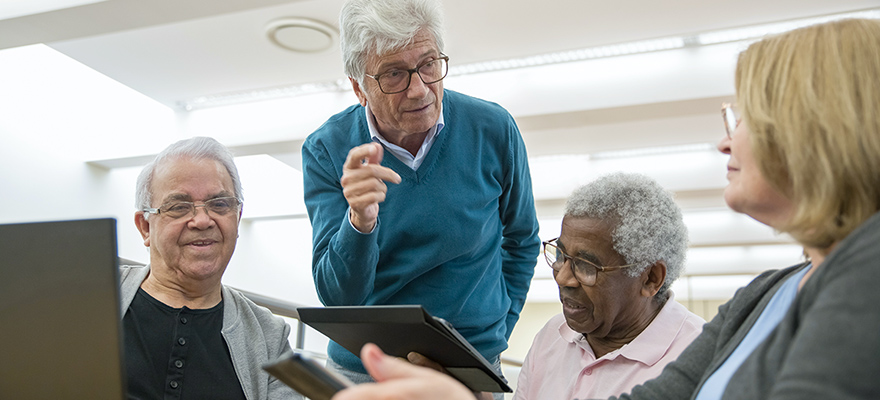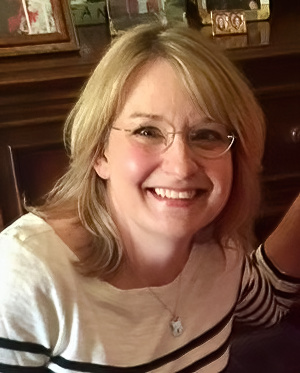Using ‘SuperAgers’ to help unlock mysteries of the human brain

By Todd Devlin
Think of it like reverse engineering. Not a machine, or a computer software program – but the human brain.
If you study Parkinson’s disease, Angela Roberts says, you only see Parkinson’s disease. Study dementia and you only see dementia. Even studying ‘typically aging’ brains often yields information about brains on a course towards developing an age-related disease such as dementia.
But what if you study ‘SuperAgers’ – individuals who, in their 80s, 90s and beyond, have experienced exceptional cognitive aging? What secrets lie within those brains? And will research in that area help improve cognitive aging outcomes for future generations? Roberts certainly thinks so.

Angela Roberts, School of Communication Science and Disorders
“If we’re going to understand what happens in these diseases that slowly deteriorate the brain and cognitive functions over time, then let’s look at people for whom that doesn’t happen,” said Roberts, an assistant professor in the School of Communication Sciences and Disorders who holds a joint appointment in the Department of Computer Science. “Let’s see what’s different between the two. Is it something in diet? Something in lifestyle? Genetics? What is it that defines exceptional aging?”
Roberts heads up the research team for the first Canadian cohort of ‘SuperAgers,’ a population group of around 500 individuals who are helping the scientific community unlock some of the mysteries around the human brain and its aging processes.
Part of a large international consortium led by researchers at Northwestern University, the study will compare its findings with neurodegenerative disease cohorts from studies funded by the Ontario Brain Institute. The goal of the work, Roberts says, is to better understand predictors of different aging trajectories.
“We’re looking to find out what are those risk factors – the ones we can change, and the ones we can’t – that will shift that trajectory,” she said. “The ultimate problem we hope to solve is how do we take someone who might be at higher risk (for dementia) because of their genetics and actually change that risk profile?”
Genetics are just one variable, of course. Roberts and her team identify ‘markers,’ meaning a signal, a behaviour, anything that defines one particular group – or acts as a separator between two groups. Physical activity might be a marker, for instance; Sleep stages might be another.
“Our team focuses on markers of cognitive aging, exceptional and otherwise in naturalistic behaviours,” Roberts said. “We look at talking and movement – how people are using words, how they pause, the types of errors they make when they’re talking. We try to pick out, is there any signal that gives us a hint that the brain is starting to change in a way that is leading toward dementia?
“These markers are behaviours that we see in everyday activities,” she added. “We certainly work with our colleagues to do genetics and brain imaging, but what (our team) is really after is what does the aging trajectory – either being exceptional or developing a brain disease – look like in everyday behaviours?”
The ‘SuperAger’ study approach – understanding a condition by looking at its opposite – has been a hallmark of Roberts’ research throughout her career. After completing a PhD and postdoctoral training in Western University’s Graduate Program in Health and Rehabilitation Sciences (2014), she took her first faculty position at Northwestern University in Chicago, where she spent much of her time researching Parkinson’s disease and other neurodegenerative brain disorders.
“The ultimate problem we hope to solve is how do we take someone who might be at higher risk (for dementia) because of their genetics and actually change that risk profile?”
Shortly after joining the SuperAging Research Initiative in 2021, the opportunity arose for Roberts to return to Western, where she’d also spent 10 years working as a clinical speech-language pathologist on the neurology unit at London Health Sciences Centre (LHSC).
“There’s nothing like having your research program embedded in a Canadian model of collaboration,” Roberts said. “It is unique amongst research environments in the world.”
Roberts is also a founding Co-Director of Western’s Collaborative Specialization in Machine Learning in Health and Biomedical Sciences, designed both to provide students with an understanding of artificial intelligence (AI) and machine learning and to enhance communication across disciplines. Think engineers talking to health scientists; or anatomy and cell biologists talking to computer scientists.
“We know that science in silos does not work,” said Roberts. “The idea here is that if we can help people have a greater understanding of one another’s perspective, help them communicate effectively, build teams and understand each other’s science, then we really hold some important keys to accelerating discoveries that help not just the health of Canadians, but the health of people around the world.”
Roberts’ research focus certainly impacts people worldwide. According to the World Health Organization (WHO), more than 55 million people live with dementia, with 10 million new cases diagnosed annually. Dementia is cited as one of the major causes of disability and dependency among older people globally.
“Not everyone has resources for ‘gold standard’ diagnostics,” Roberts says. “There are big disparities in access and getting an accurate dementia diagnosis. That’s where we look at tools that might be able to reach people who live in more remote regions. We need to make sure that no matter where people live, they still have access.”
One of those tools is a telehealth delivery system which Roberts and her team use for various studies. Her work uses randomized control trial designs. In fact, her team conducted the first rigorous randomized control trial of speech-language interventions for persons with primary progressive aphasia (PPA), a rare – but devastating – form of dementia that strikes earlier than most (often between age 55 to 65).
In part because of her career as a clinician, Roberts is adamant about involving her patients and participants in all aspects of the research.
“There’s a bit of a mantra in this work: ‘Nothing about us without us.’ Someone with Parkinson’s disease said that to me for the first time 10 years ago, and we’ve really taken that to heart,” she said. “We try not to engage in research or publish research about any group unless that group is sitting at the table. So, they are regular members of our lab, they go over the data with us, and they even help us write the papers.”
The research creates close connections between Roberts and the individuals and families she works with. Some days, it can be heavy. It can certainly be emotionally draining. But it’s the human connection that keeps Roberts motivated.
“Being part of someone's journey, no matter how hard that is, and being a companion in that journey with them and their family … there is no better job in the world,” she said. “It’s an opportunity to help people and families hold on to a sense of identity, their sense of who they are.
“You draw courage from them. They are your heroes. There’s not a single family I work with, not a single patient I work with who’s not truly my hero.”

